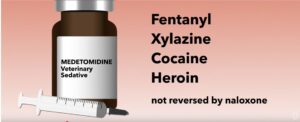Fentanyl replaced heroin in the drug market, and then xylazine or “tranq” began to appear as an adulterant in dope stamp bags. Xylazine is a non-opioid veterinary sedative and was first noted as an opioid adulterant in Puerto Rico in the early 2000s. According to the DEA, by October of 2022 xylazine-positive overdoses were present in all four census regions of the U.S. Philadelphia had become the epicenter of the xylazine crisis and drug users began to appear at wound care clinics with wounds from tissue death or necrosis. But then a new veterinary sedative called medetomidine began to be detected in the illicit drug supply.
The Philadelphia Department of Public Health (PDPH) only began testing for medetomidine around the end of April of 2024. It was previously detected in Maryland, Ohio, Florida and Canada. All the samples at the time with medetomidine also contained xylazine and fentanyl. Similar to xylazine, medetomidine is a sedative used in veterinary medicine. But it is more potent than xylazine, producing greater and longer lasting sedation.
Medetomidine is metabolized by the liver, and, when used alone, peak plasma levels occur within 10-30 minutes of administration and the elimination half-life is 1.6 hours. The duration of sedation provided by medetomidine lasts for 2-3 hours, but sedation can be prolonged with co-administration of opioids.
The Drug Supply in Philadelphia
The Conversation reported xylazine was first detected in Philadelphia street drugs in 2006 and became more common in 2015. “By early 2023, xylazine was detected in 98% of tested dope samples in the city.” But medetomidine has now emerged as a primary adulterant and is twice as common as xylazine. By the end of 2024, 46 of the people who died from fatal overdoses in Philadelphia tested positive for medetomidine.
The sedating effects of medetomidine are similar to xylazine, but 10 to 20 times stronger. Since medetomidine is so powerful and does not act on opioid receptors, it complicates opioid overdose treatment with naloxone. Patients start to breathe normally, but additional doses of naloxone risk prompting opioid withdrawal symptoms. Additionally, patients often experience rapid heart rate, severe spikes in blood pressure, restlessness, disorientation and confusion, and severe vomiting.
Researchers and clinicians in Philadelphia’s hospitals, including us at Thomas Jefferson University, are analyzing emerging clinical data. This data suggests that existing protocols that effectively controlled withdrawal symptoms in the era when xylazine was common are no longer adequate in the era of medetomidine. New protocols have been developed based on the guidance of local experts and are being tested.
The CDC reported that medetomidine replaced xylazine as the most common drug adulterant in the illegal opioid supply in Philadelphia during the last 4 months of 2024. During that same time period, xylazine decreased from 98% to 31% of tested samples. There was also an increased number of hospitalized patients with severe drug withdrawal syndrome distinct from fentanyl and xylazine withdrawal. These symptoms were characterized by severe hypertension and tachycardia.
Between September 1, 2024 and January 31, 2025, 150 of 165 patients (91%) whose withdrawal syndrome was not resolved by established treatment protocols for fentanyl and xylazine required ICU care, including 40 (24%) who received endotracheal intubation, a medical procedure to keep the airway open in order to give oxygen, medicine or anesthesia.
Public Health Needs, Medetomidine and Dex
In The Lancet, David Zhu and Joseph Palamar said in “Responding to medetomidine clinical and public health needs” that the emergence of medetomidine as an adulterant in the illicit U.S. drug supply was a troubling development in the escalating polysubstance crisis. “Medetomidine toxicity resembles xylazine toxicity but is often more severe and prolonged due to its higher potency.” The authors suggested clinicians maintain a high index of suspicion with cases of prolonged sedation despite naloxone administration.
Emergency departments and clinics should adapt protocols to address the sedative and cardiovascular effects of medetomidine, particularly respiratory depression and hemodynamic instability. Preparedness for advanced airway management, ventilatory support, and vasopressor therapy is essential. Clonidine, which has shown efficacy in managing dexmedetomidine withdrawal, may be considered for hemodynamically stable patients with persistent symptoms despite receiving opioid agonist therapy. While naloxone does not directly reverse medetomidine toxicity, as it is not an opioid, it should still be administered in suspected overdoses due to its frequent co-adulteration with fentanyl.
The authors thought the burgeoning medetomidine overdose crisis demands there be coordinated actions from clinicians, public health agencies, and policy makers. They thought the tools for an effective response were within reach and included: developing medetomidine-specific clinical guidelines, expanding epidemiological surveillance (tracking diseases, detecting outbreaks, and evaluating the effectiveness of public health interventions), and fostering collaboration between agencies. “However, their success hinges upon our collective resolve to implement them. At this critical juncture, we have an opportunity to act proactively—the question is whether we will act with the urgency the crisis demands.”
STAT said in the past year, in addition to Philadelphia, medetomidine has become increasingly common part of the drug supply—and overdoses—in the cities of Pittsburgh, Chicago, and San Francisco. As law enforcement cracked down on xylazine, a pharmacologically active form of medetomidine known as dexmedetomidine or “dex” took its place. An emergency and addiction medicine physician at the University of Pennsylvania said the supply has shifted heavily from xylazine to medetomidine. “With withdrawal from medetomidine, severe cases can be life-threatening. And the scary part is that we don’t have a way right now to predict who will be at risk for severe withdrawal and who’s not.”
There was a CDC Morbidity and Mortality Weekly Report (MMWR) on May 1, 2025 that described 23 patients between October 2024 and March 2025 who experienced severe autonomic hyperactivity after abrupt cessation of illegal opioids requiring treatment at hospitals in Pittsburgh. Medetomidine was detected in two patients; but the test was technically unable to detect medetomidine metabolites. “As concern grew about an emerging outbreak of a novel withdrawal syndrome, retrospective analysis of this comprehensive drug screening data was performed for 10 patients after they had been discharged; medetomidine metabolites were detected in all 10 samples.”
The 10 patients who used illegally manufactured opioids with confirmed medetomidine exposure based on retrospective identification of medetomidine metabolites exhibited a withdrawal syndrome characterized by severe autonomic hyperactivity with rapid symptom onset often requiring dexmedetomidine and ICU admission. The emergence of this syndrome temporally correlated with an increased medetomidine prevalence in the regional illegally manufacture opioid supply. On December 18, 2024, the Pennsylvania Department of Health issued a health advisory describing severe withdrawal observed in patients who use drugs in the Philadelphia area associated with medetomidine exposure. Although only two patients had detectable parent medetomidine on comprehensive urine drug screening, all 10 patients had samples with detectable medetomidine metabolites identified retrospectively. Although a rapid clinical test for medetomidine is not available, providers should maintain awareness of this emerging medetomidine withdrawal syndrome when treating persons who use illegally manufactured opioids.
A pharmacoepidemiologist from North Carolina thought the proliferation of dexmedetomidine was inevitable. “We saw our first dexmedetomidine samples in 2022, and it was like: Duh, it’s obvious that this is what’s going to replace xylazine when xylazine gets cracked down on.” Dexmedetomidine has had a lot of manufacturing, it’s used in every hospital, and is known to be very safe without known skin complications. “So it was just a matter of time before the market would have switched to dex anyways.”
Drug overdoses involving medetomidine can cause severe drops in heart rate and blood pressure. But medetomidine withdrawal symptoms result in the opposite: the sympathetic nervous system skyrockets, causing elevated heart rate and blood pressure “that can damage organs including the heart and brain.” This is different from xylazine withdrawal, which is often milder with feelings of anxiety or restlessness—not vital sign abnormalities. After temporarily classifying xylazine as a Schedule III controlled substance in 2023, Governor Josh Shapiro of Pennsylvania made the change permanent in May of 2024.
Like xylazine, formulations of medetomidine are sometimes used in veterinary settings. But they are used to treat humans, too, often under the brand name Precedex, a medication that is used for sedation in both adult and pediatric settings but not typically associated with misuse or addictive potential.
It’s really changed opiate withdrawal from something that typically can be handled at home, sometimes in behavioral health facilities like detoxes that are not hospital level of care, to this opioid-plus-medetomidine withdrawal, which can be life-threatening.
Although they look almost identical, xylazine and dexmedetomidine have very different properties. Beyond the potentially heightened risk for hard-to-reverse overdoses and medically dangerous withdrawal, the powerful sedative properties of dex leave many individuals vulnerable. “Dex is way more sedating than even xylazine was.” So people may wake up in compromised positions; perhaps with their possessions stolen or having been assaulted. “That’s already a fear with xylazine. It’s something where we warn people to be careful of their surroundings. It’s even more so with dex.”
The illicit drug trade seems to be ever shifting, often making the public health measures developed to address its latest phase inadequate. Heroin shifted from being adulterated with fentanyl to pure fentanyl, which led to fentanyl adulterated with xylazine, and now there’s medetomidine mixed with fentanyl. However, there is a silver lining with medetomidine withdrawal. Unlike xylazine causing deep skin wounds, infections, and necrosis (the death of body tissue), medetomidine has not been known to cause similar wounds. I wonder what will the next phase of the opioid crisis bring?





